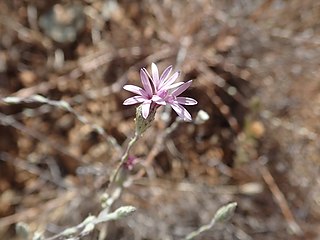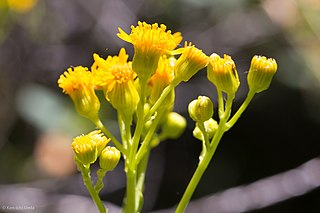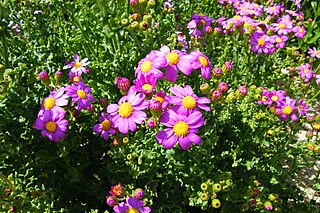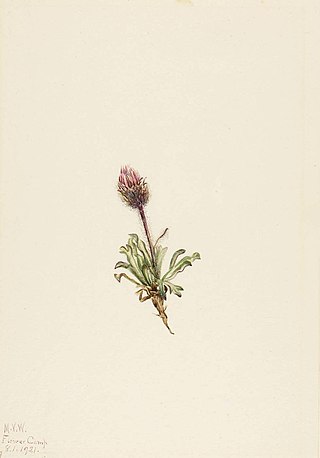
Calycadenia is a genus of flowering plants in the family Asteraceae, known commonly as the western rosinweeds. They are native to California, especially around the Central Valley. The ranges of two species (C. fremontii + C. truncata) do extend north into Oregon.

Coreopsis calliopsidea is a species of flowering plant in the daisy family known by the common name leafstem tickseed. It is endemic to California. The plant grows in some of the southern coastal mountain ranges and Transverse Ranges and the Mojave Desert from Alameda and Inyo Counties south to Riverside County.

Helianthella californica is a species of flowering plant in the family Asteraceae known by the common name California helianthella. This wildflower is native to the mountains of California, northwestern Nevada, and southwestern Oregon.

Layia chrysanthemoides is a species of flowering plant in the family Asteraceae known by the common name smooth tidytips, or smooth layia.

Corethrogyne filaginifolia is a species of flowering plant in the daisy family known by the common names common sandaster and California aster.

Lessingia glandulifera is a species of flowering plant in the family Asteraceae known by the common name valley lessingia. It is native to California and Baja California, where it grows in several types of habitat, from forest and desert to the coastline. This is an annual herb varying in maximum size from under 10 to nearly 80 centimeters in height, growing erect to decumbent. It is hairless to very hairy and glandular. The leaves are widely lance-shaped and toothed, the lowest approaching 11 centimeters in maximum length. The upper leaves are often studded with knobby glands. The flower heads appear singly at the tips of the stem branches. Each head is lined with phyllaries covered in large glands and sometimes many hairs. The head is discoid, containing no ray florets but many funnel-shaped disc florets with lobes that resemble ray florets. The disc florets are yellow with brown throats. The fruit is an achene with a whitish pappus.

Lessingia hololeuca is a species of flowering plant in the family Asteraceae known by the common name woollyhead lessingia.

Lessingia leptoclada is a species of flowering plant in the family Asteraceae known by the common name Sierra lessingia. It is endemic to the Sierra Nevada of California, where it is known from several types of local habitat. This is a slender annual herb growing erect and varying in size from just a few centimeters to nearly a meter tall, with long, spreading branches. It is very glandular and often hairy or woolly in texture. The upper leaves are up to 5 centimeters long, narrow and sometimes toothed or lobed; the lower leaves are longer and wither early. The flower heads appear singly or in small clusters. Each head is lined with woolly phyllaries. The head is discoid, containing no ray florets but many funnel-shaped pinkish, lavender, or light bluish-purple disc florets with large lobes. The fruit is an achene with a whitish pappus of bristles.
Lessingia micradenia is a rare species of flowering plant in the family Asteraceae known by the common name Mt. Tamalpais lessingia. It is endemic to the San Francisco Bay Area of California, where it occurs in areas with serpentine soils. The species is divided into two rare varieties, each with a limited occurrence on opposite sides of the Bay Area. Lessingia micradenia var. glabrata is found in several locations across Santa Clara County south of San Jose, while var. micradenia is known only from a few spots around Mount Tamalpais in Marin County.
Lessingia tenuis is a species of flowering plant in the family Asteraceae known by the common name spring lessingia. It is endemic to California, where it is known from the San Francisco Bay Area to Ventura County. It grows on the slopes of the California Coast Ranges in common local habitat such as chaparral.
Kyhosia is a monotypic genus of flowering plants in the family Asteraceae containing the single species Kyhosia bolanderi, which is known by the common names Bolander's madia and kyhosia.

Pleurocoronis pluriseta is a species of flowering plant in the family Asteraceae known by the common name bush arrowleaf. It is native to the southwestern United States and northern Mexico, where it grows in desert scrub and similar habitat. This is a clumpy or bushy subshrub reaching up to about half a meter in maximum height with many slender branches. The distinctive leaves are several centimeters in length and are mostly petiole; there is generally a toothed diamond- or arrowhead-shaped blade no more than one centimeter long at the very tip. The inflorescence is made up of one or two flower heads, sometimes more. Each flower head is somewhat cylindrical or bullet-shaped, measuring up to about a centimeter long. The head is discoid, containing only disc florets and no ray florets. It is lined with a series of many phyllaries coated thinly in glandular hairs and often streaked with purple-red coloration. The tips of the outer phyllaries curve outward. The fruit is a hairy, ribbed achene a few millimeters long with a pappus of bristles and scales on its tip.

Rudbeckia californica is a species of flowering plant in the family Asteraceae, known by the common name California coneflower.

Rudbeckia occidentalis is a species of flowering plant in the family Asteraceae known by the common name western coneflower. It is native to the northwestern United States from Washington to northern California and east to Wyoming and Montana, where it grows in moist habitat types, such as meadows. It is an erect perennial herb growing from a thick rhizome, its mostly unbranched stem approaching two meters in maximum height. The large leaves are generally oval but pointed, and lightly to deeply toothed along the edges, growing to 30 centimeters long. The inflorescence is one or more flower heads with purplish bases up to 6 centimeters wide. There are no ray florets, just an array of reflexed phyllaries around the purple-brown center packed with disc florets. This center, containing the receptacles, lengthens to several centimeters in length as the fruits develop. The fruits are achenes each a few millimeters long, some tipped with pappi of tiny scales.

Packera clevelandii is an uncommon species of flowering plant in the aster family known by the common name Cleveland's ragwort. It is endemic to California, where it is known from only two small regions, a section of the North Coast Ranges around Napa County and a part of the Sierra Nevada foothills on the opposite side of the Sacramento Valley. The plant grows in shrubby chaparral on serpentine soils.

Senecio elegans is a species of flowering plant in the aster family known by the common names redpurple ragwort, purple groundsel, wild cineraria and purple ragwort.
Packera ganderi is a rare species of flowering plant in the aster family known by the common name Gander's ragwort. It is endemic to southern California, where it is known from a few occurrences in San Diego and Riverside Counties.

Packera greenei is a species of flowering plant in the aster family known by the common name flame ragwort. It is endemic to northern California, where it is known from the North Coast Ranges and southern Klamath Mountains. It is a resident of dry mountain scrub habitat, often on serpentine soils.

Solidago multiradiata is a species of goldenrod known by the common names Rocky Mountain goldenrod, northern goldenrod, and alpine goldenrod. It is native to North America, where it can be found throughout the northern regions, including Alaska and most of Canada (all 3 territories plus all provinces except Prince Edward Island, including territory north of the Arctic Circle. Its distribution extends through the western United States as far south as Arizona, New Mexico, and California. It is known mostly from the subalpine and alpine climates of high mountain ranges. Its habitat includes tundra and mountain meadows.

Erigeron lanatus is a species of flowering plant in the family Asteraceae known by the common name woolly fleabane. It is native to western North America, where it occurs in the mountains straddling the border between British Columbia and Alberta and Montana, with isolated populations occurring as far north as Yukon and as far south as Colorado.
















